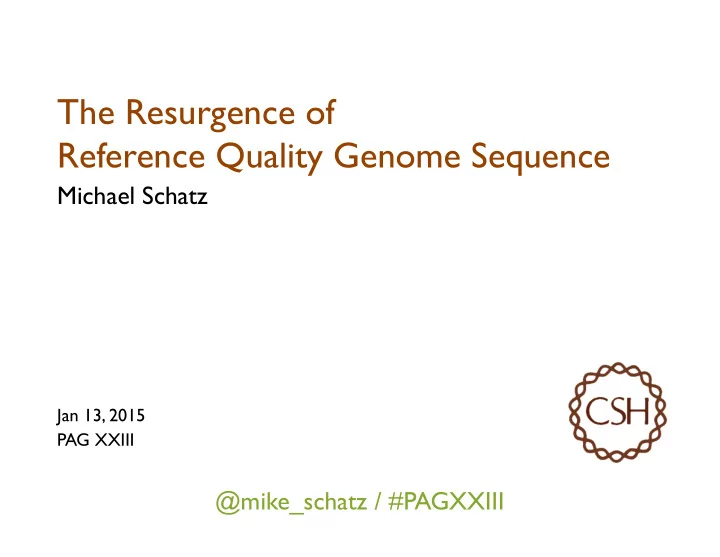

The Resurgence of Reference Quality Genome Sequence Michael Schatz Jan 13, 2015 PAG XXIII @mike_schatz / #PAGXXIII
Contig N50: 5.1Mbp Total projects costs: >$100M
Short Read Assembly Results Total costs: ~$10k W.R. McCombie >1,000x times cheaper, but at what cost scientifically?
Genomics Arsenal in the year 2015 Sample Preparation Sequencing Chromosome Mapping
Population structure of Oryza sativa Indica Total Span: 344.3 Mbp Contig N50: 22.2kbp Aus Nipponbare Total Span: 344.9Mbp Total Span: 354.9Mbp Contig N50: 25.5kbp Contig N50: 21.9kbp Whole genome de novo assemblies of three divergent strains of rice ( O. sativa ) documents novel gene space of aus and indica Schatz, Maron, Stein et a l (2014) Genome Biology. 15:506 doi:10.1186/s13059-014-0506-z
Oryza sativa Gene Diversity • Very high quality representation of the “gene-space” • Overall identity ~99.9% • Less than 1% of exonic bases missing • Genome-specific genes enriched for disease resistance • Reflects their geographic and environmental diversity Overall sequence content ! In each sector, the top number is the total number of base pairs, the • Assemblies fragmented at (high copy) middle number is the number of exonic bases, and the bottom is the repeats gene count. If a gene is partially • Difficult to identify full length gene shared, it is assigned to the sector with the most exonic bases. ! models and regulatory features
Long Read Sequencing Technology Moleculo PacBio RS II Oxford Nanopore 0 10k 20k 30k 40k 10k 20k 30k 0 40k (Voskoboynik et al. 2013) CSHL/PacBio CSHL/ONT
O. sativa pv Indica (IR64) PacBio RS II s equencing at PacBio • Size selection using an 10 Kb elution window on a BluePippin™ device from Sage Science Over 118x coverage using P5-C3 long read sequencing Mean: 5918bp 49.7x over 10kbp 6.3x over 20kb Max: 54,288bp
O. sativa pv Indica (IR64) Genome size: ~370 Mb Chromosome N50: ~29.7 Mbp Assembly Contig NG50 HGAP Read Lengths Max: 53,652bp MiSeq Fragments 19 kbp 22.7x over 10kbp 25x 456bp (discarded reads (3 runs 2x300 @ 450 FLASH) below 8500bp) “ALLPATHS-recipe” 18 kbp 50x 2x100bp @ 180 36x 2x50bp @ 2100 51x 2x50bp @ 4800 HGAP + CA 4.0 Mbp 22.7x @ 10kbp Nipponbare 5.1 Mbp BAC-by-BAC Assembly
S5 Hybrid Sterility Locus Sanger ! ! …ACCCTGATATTCTGAGTTACAAGGCATT C AGCTACTGCTTGCCCACTGACGAGACC… ! Illumina ! …ACCCTGATATTCTGAGTTACAAGGCATT C AGCTACTGCTTGCCCACTGACGAGACC… ! PacBio ! ! …ACCCTGATATTCTGAGTTACAAGGCATT C AGCTACTGCTTGCCCACTGACGAGACC… ! S5 is a major locus for hybrid sterility in rice that affects embryo sac fertility. ! • Genetic analysis of the S5 locus documented three alleles: an indica (S5-i), a japonica (S5- j), and a neutral allele (S5-n) ! • Hybrids of genotype S5-i/S5-j are mostly sterile, whereas hybrids of genotypes consisting of S5-n with either S5-i or S5-j are mostly fertile. ! • Contains three tightly linked genes that work together in a ‘killer-protector’-type system: ORF3, ORF4, ORF5 ! • The ORF5 indica (ORF5+) and japonica (ORF5-) alleles differ by only two nucleotides !
S5 Hybrid Sterility Locus Sanger ! ! …ACCCTGATATTCTGAGTTACAAGGCATT C AGCTACTGCTTGCCCACTGACGAGACC… ! Illumina ! …ACCCTGATATTCTGAGTTACAAGGCATT C AGCTACTGCTTGCCCACTGACGAGACC… ! PacBio ! ! …ACCCTGATATTCTGAGTTACAAGGCATT C AGCTACTGCTTGCCCACTGACGAGACC… ! 100kbp
S5 Hybrid Sterility Locus Sanger ! ! …ACCCTGATATTCTGAGTTACAAGGCATT C AGCTACTGCTTGCCCACTGACGAGACC… ! Illumina ! …ACCCTGATATTCTGAGTTACAAGGCATT C AGCTACTGCTTGCCCACTGACGAGACC… ! PacBio ! ! …ACCCTGATATTCTGAGTTACAAGGCATT C AGCTACTGCTTGCCCACTGACGAGACC… !
5.3Mbp Improvements from 20kbp to 4Mbp contig N50: • Over 20 Megabases of additional sequence • Extremely high sequence identity (>99.9%) • Thousands of gaps filled, hundreds of mis-assemblies corrected • Complete gene models, promoter regions for nearly every gene • True representation of transposons and other complex features • Opportunities for studying large scale chromosome evolution • Largest contigs approach complete chromosome arms
Current Collaborations Human CSHL/OICR Asian Sea Bass Temasek Life Sciences Pineapple UIUC T. vaginalis M. ligano NYU Hannon
P6-C4
“Perfect” Advances in Assembly Human Assembly “Perfect” Higher Euk. “Perfect” Simple Ag. Genomes “Perfect” Model Orgs. P6-C4 “Perfect” Fungi “Perfect” Microbes First Hybrid Assembly First PacBio RS @ CSHL Error correction and assembly complexity of single molecule sequencing reads. Lee, H*, Gurtowski, J*, Yoo, S, Marcus, S, McCombie, WR, Schatz, MC http://www.biorxiv.org/content/early/2014/06/18/006395
Pan-Genome Alignment & Assembly A" B" C" D" Time to start considering problems Pan-genome colored de Bruijn graph ! for which N complete genomes is the • Encodes all the sequence input to study the “pan-genome” ! relationships between the genomes ! • Available today for many microbial • How well conserved is a given species, near future for higher sequence? ! eukaryotes ! • What are the pan-genome network properties? ! SplitMEM: A graphical algorithm for pan-genome analysis with suffix skips Marcus, S, Lee, H, Schatz MC (2014) Bioinformatics. doi: 10.1093/bioinformatics/btu756 Extending reference assembly models Church, D. et al . (2015) Genome Biology. In Press.
Summary & Recommendations Reference quality genome assembly is here – Use the longest possible reads for the analysis – Don’t fear the error rate, coverage and algorithmics conquer most problems Megabase N50 improves the analysis in every dimension – Better resolution of genes and flanking regulatory regions – Better resolution of transposons and other complex sequences – Better resolution of chromosome organization – Better sequence for all downstream analysis ! The year 2015 will mark the return to ! reference quality genome sequence ! !
Acknowledgements Schatz Lab CSHL Rahul Amin Hannon Lab Eric Biggers Gingeras Lab Han Fang Jackson Lab Tyler Gavin Hicks Lab James Gurtowski Iossifov Lab Ke Jiang Levy Lab Hayan Lee Lippman Lab Zak Lemmon Lyon Lab Shoshana Marcus Martienssen Lab Giuseppe Narzisi McCombie Lab Maria Nattestad Tuveson Lab Aspyn Palatnick Ware Lab Srividya Wigler Lab Ramakrishnan Rachel Sherman IT & Meetings Depts. Greg Vurture Pacific Biosciences Alejandro Wences Oxford Nanopore
Thank you http://schatzlab.cshl.edu @mike_schatz / PAGXXIII
O. sativa pv Indica (IR64) S5 Hybrid Sterility Locus Sanger ! …ACCCTGATATTCTGAGTTACAAGGCATT C AGCTACTGCTTGCCCACTGACGAGACC… ! Illumina ! …ACCCTGATATTCTGAGTTACAAGGCATT C AGCTACTGCTTGCCCACTGACGAGACC… ! PacBio ! …ACCCTGATATTCTGAGTTACAAGGCATT C AGCTACTGCTTGCCCACTGACGAGACC… ! 100kbp 5.3 Mbp
Recommend
More recommend